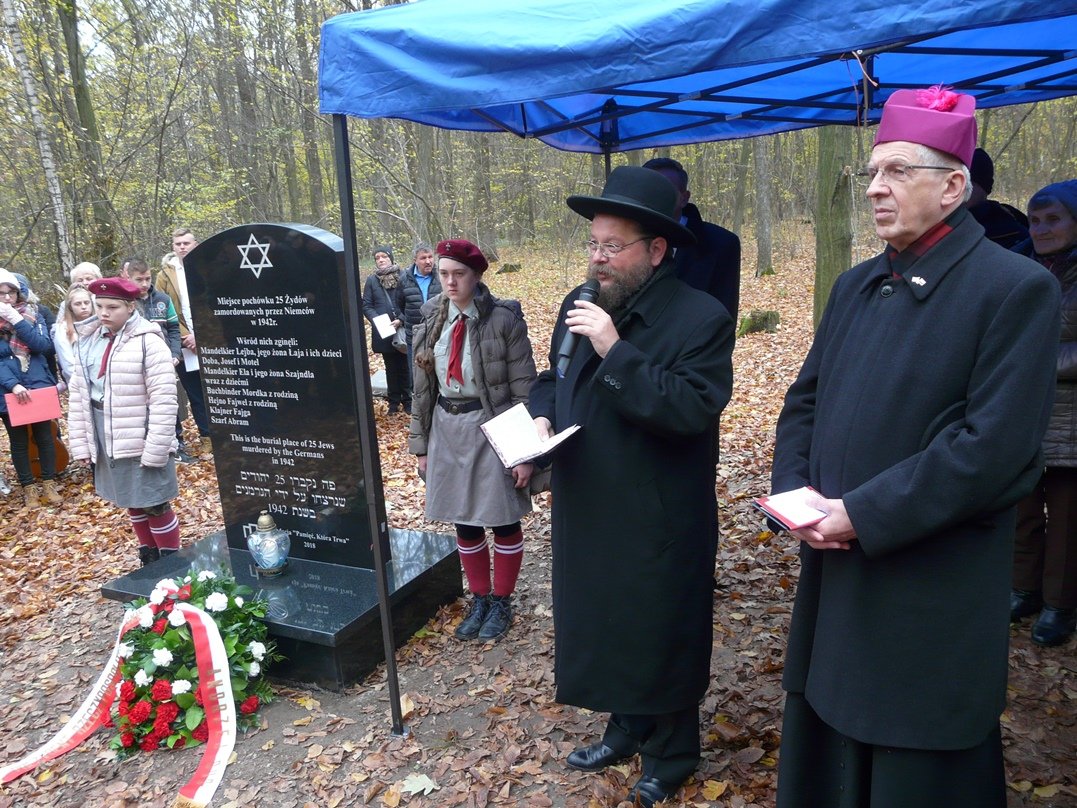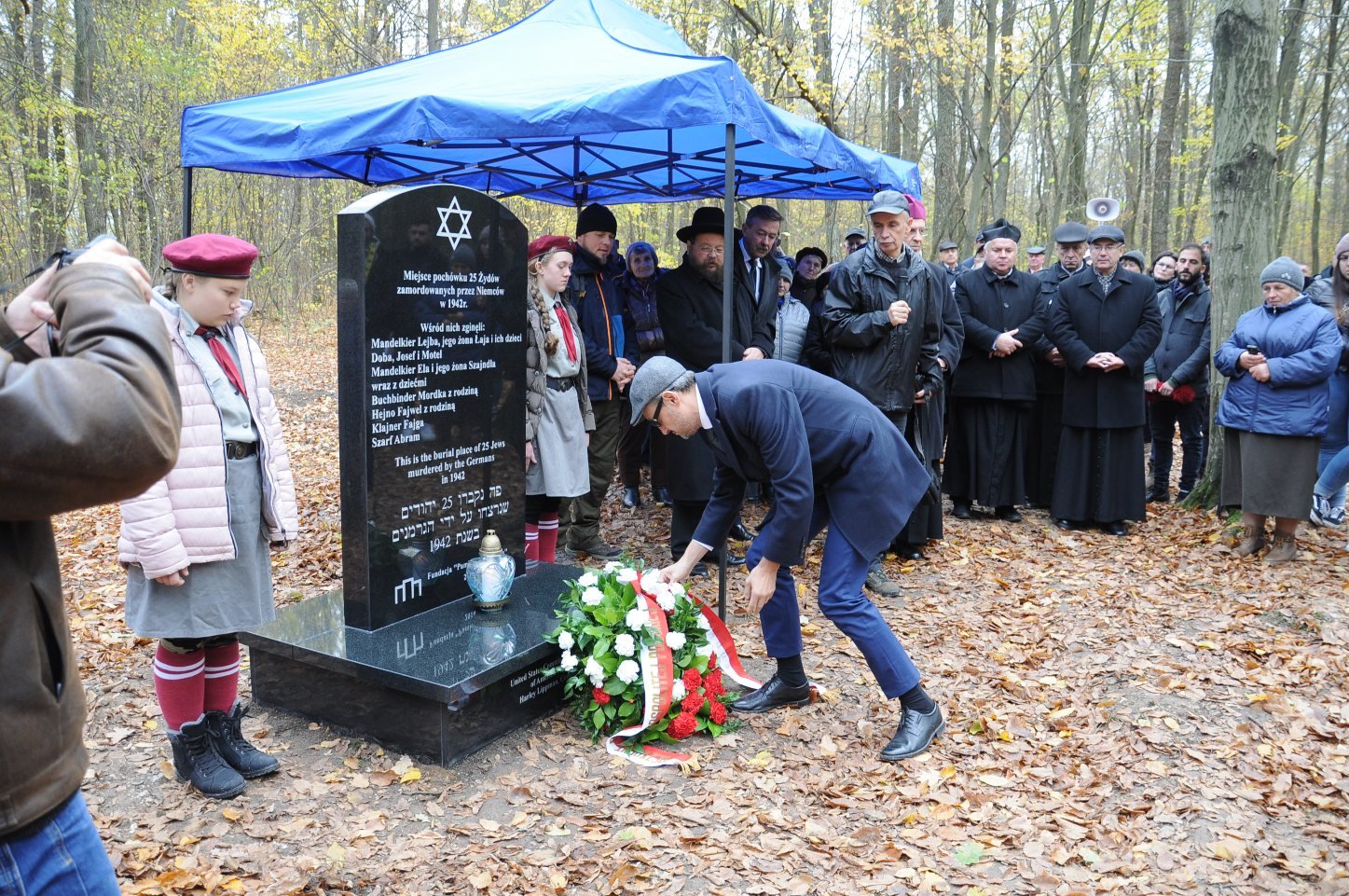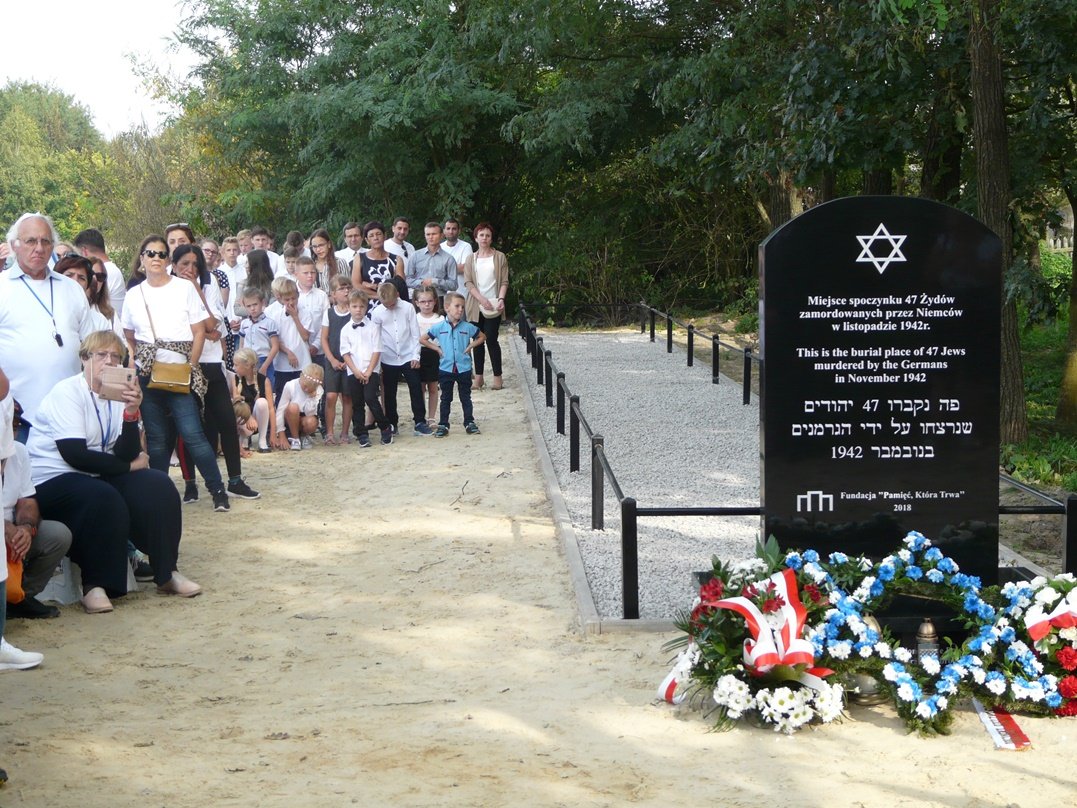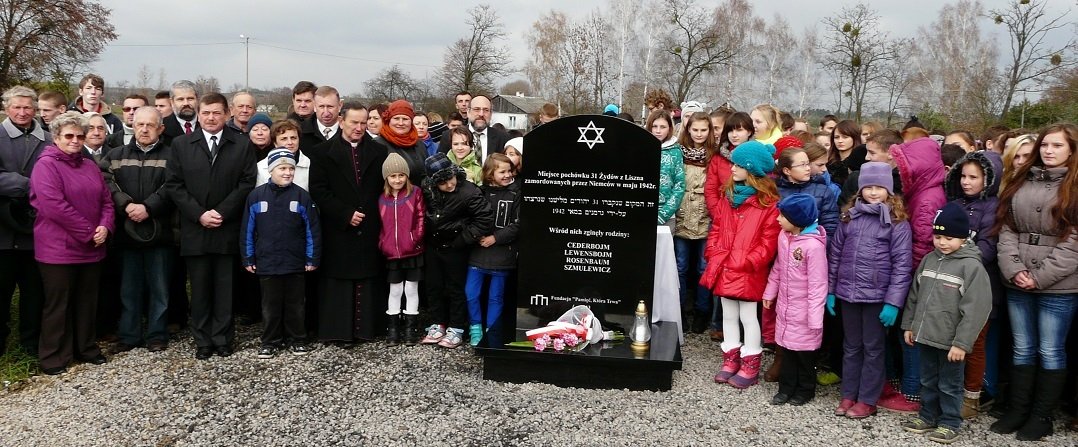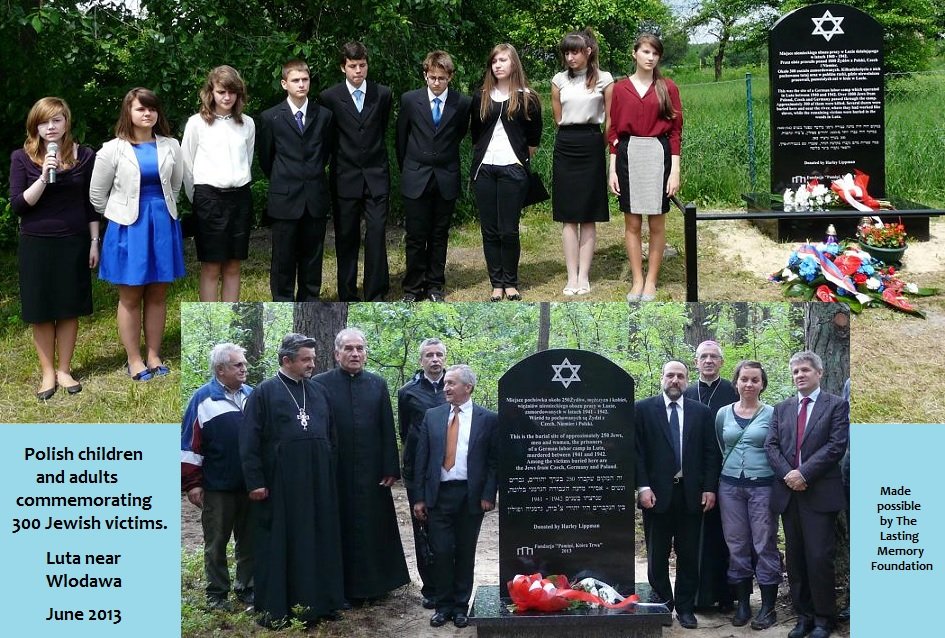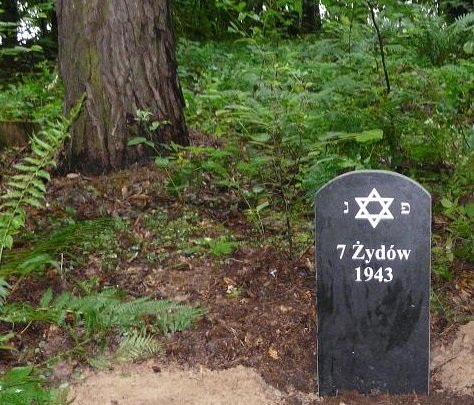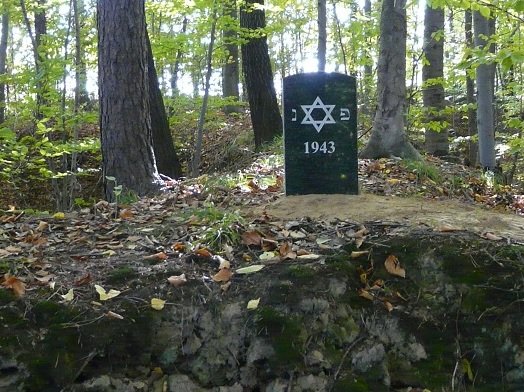The Lasting Memory Foundation: Poland
This website was created to encourage support of the Lasting Memory Foundation of Poland. This is an organization, led by Zbigniew Nizinski, whose mission is to locate the unknown and forgotten places of mass burial through the people who witness testimony.
The foundation's work involves the discovery of the unmarked mass graves, identification of the names of victims buried there so that they no longer remain anonymous, and commemoration of these sacred spots. Since most of the witnesses were teens or young adults during 1941-45, the years of the Holocaust, they are now quite elderly — and therefore they must be contacted soon so they do not pass away with their secrets untold. The Foundation invites government officials, clergy, students, and town residents to unveiling ceremonies to share the experience with the local (mostly non-Jewish) population.
Please consider donating to Mr. Nizinski’s project, the Lasting Memory Foundation:
The funds donated go directly to finding the victims of the Shoah, interviewing witnesses and creating plaques and memorials to permanently remember them. Below are some examples of the amazing work carried out by this organization.
E-mail: info@fpkt.org.pl
Web: www.fpkt.org.pl
Address: Fundacja Pamiec Ktora Trwa
ul. Grojecka 22/24 lok. 32
02-301 Warszawa, Poland
The Lasting Memory Foundation placed this plaque at Mojsławice-Kolonia, near Uchanie, Poland (Lublin district), in 2012. It commemorates the victims of the Chelm-Hrubieszow Death March.
Recent Activities —
Olchowiec near Biłgoraj —
In 2018, the Lasting Memory Foundation had a ceremony in Olchowiec near Biłgoraj which commemorated 47 victims of the Holocaust. The Foundation also held a meeting between its board and the administrator of Obsza community, along with a teacher and students from a school in Olchowiec. The participants reminisced about the victims and lit candles at the grave.
Bzowiec near Zolkiewka/Szczebreszyn — In a forest in the town of Bzowiec, the Lasting Memory Foundation commemorated a burial place of 25 Jews (men, women and children murdered by the Germans in 1942). The memorial took place in October of 2018. Their first and last names were inscribed on the Memorial. The unveiling ceremony conducted by the Foundation was attended by more than 200 people from Poland and Israel who gathered to pay tribute to the dead and restore the memory of their lives. Victims memorialized on the plaque: Mordko Buchbinder and family; Josef and Motel Doba; Fajwel Hejno; Fajga Klajner; Lejb Mandelkier; Ela and Szandla Mandelkier; and Abram Szarf. The murdered Jews were mostly residents of Bzowiec and Kitów. When in spring 1942 the Germans ordered them to report to the ghetto in Gorzków, they decided to run away and find a hiding place with the support of the owner of a local manor house and the residents, which lasted a few months. The Mayor Tadeusz Zdunek told the story of those tragic events: In September of 1942, the German military police arrived in Bzowiec. The Jews were rounded up on one of the farms and executed in the backyard in the presence of many witnesses. It was ordered that the bodies were to be transported to the woods and buried in a nameless grave. Among the dignitaries who participated in the ceremony: Jakub Beczek, Cantor Symcha Keller, Bishop Mieczysław Cisło with priests of three local parishes, Mayor Tadeusz Zdunek, a group of 100 students from the town of Or-Yehuda in Israel, Junior High School students from Rudnik along with their Principal Mariusz Żarnowski, members of a regional society and the residents of Bzowiec and adjacent villages. The youth from Rudnik and Israel sang songs and recited poems. The regional society band played music and performed a song. Candles were lit and wreaths laid at the Memorial.
Zalesie near Ryki — In 2017, the Lasting Memory Foundation commemorated 11 Jewish victims in Zalesie near Ryki, Poland. It lies approximately 4 kilometres (2 mi) north of Ryki and 64 km (40 mi) north-west of the regional capital Lublin. The Lasting Memory held a ceremony, photos included here. At the ceremony were local residents, school children and invited guests attended the ceremony to pay honors to the dead. Dignitaries who attended the ceremony: Jakub Beczek, Lesley Weiss, R' Michael Schudrich, Bishop Mieczysław Cisło, Artur Jaśkowski, Deputy Mayor of Ryki Magdalena Woźniak, Parish Priest Krzysztof Czyrka, Bogumiła Porowska, Hanna Witek, and village administrator Grzegorz Cieślak.
Stanisławów near Bilgoraj — In a forest in Stanisławów, the Lasting Memory Foundation located and commemorated the burial place of 25 Jews — including children — murdered in 1942. The ceremony by the victims' grave was attended by the locals, the students from a local school and invited guests who paid tribute to the dead together and took place in September of 2020. The ceremony was attended by dignitaries, including: Jakub Beczek, R’ Michael Schudrich, Bishop Mieczysław Cisło, Principal of the school in Stanisławów along with the teachers, students and the school's color guard, local authorities, clergy, the country housewives' club from Stanisławów, and residents (including the eyewitnesses) to the war. The memorial was made of local stone which was used before the war to make matzevot. After laying flowers from the President of Poland and the local authorities, the Rabbi and Bishop raised their prayers. Afterwards, the students gave an artistic performance. The tragic events that had occurred in that place in 1942 were recalled: Several Jewish families, who had been transported to Stanisławów beforehand, were brought to the forest by the German military police. After their execution, they ordered the locals to to bury the victims at the execution site. It was unmarked for 78 years.
Adamów near Zamość — In Adamów, the Lasting Memory Foundation commemorated the place of execution and burial of 20 Jews, men, women and children murdered in 1943. The ceremony next to the Victims’ grave was attended by representative of Chancellery of the President of Poland, clergy, authorities, a group of 40 people from Israel and local residents. The participants paid tribute to the victims through prayers, poems and songs. This memorial took place in May of 2019. The ceremony was attended by: Jakub Beczek, R’ Michael Schudrich, Catholic Bishop Mieczysław Cisło, Mayor of Adamów Commune, the parish priest of Krasnobród, delegation from a school in Szewnia Górna, representative of the Forest Inspectorate of Zwierzyniec, a group of 40 employees of the air industry in Israel and local residents. The ceremony was led by the Foundation’s President Zbigniew Niziński. At the end of the ceremony, the students from the school in Szewnia Górna recited touching poems and the guests from Israel sang a song. The participants laid flowers at the memorial. Afterwards, the story was told of the tragic events that took place in Adamów during the war: The Jews — most of whom came from Krasnobród, Jozefów Biłgorajski, Łódz, or Warsaw — were forced to work on a German farm. In the summer of 1943, the Jews were gathered in one building. A pit was dug out in a gorge in a local forest at the German command. The Germans led the Jews one by one, with children first, and then shot them to death. The grave remained unmarked for 76 years.
Additional Activities —
Liszno near Rejowiec — In 2013 and again in 2015, there was a ceremony of unveiling a memorial stone set up by the Lasting Mamory Foundation took place. The town’s residents, students from a local school and other guests gathered near the memorial to pay tribute to the dead. The Foundation’s president Zbigniew Niziński recalled the memories of Liszno residents regarding the Jews living in the town until May of 1942: Chaim and his sons Lejba and Lejzor had a shop; a small business was also owned by Icek. Szulim was a glassworker, and local Jews prayed in his house. Szmul was a shoemaker; Srulik owned a dairy. Necha and Chawka were traders. There was also poor Pereć, who had many children. The Jews of Liszno were murdered in May of 1942.
Family names: Cederbojm, Lewensbojm, Rozenbaum, Szmulewicz
Luta near Wlodawa — "We successfully conducted one more ceremonies commemorating the Jewish victims buried in mass graves.
I set up three memorial stones over the graves of approximately 300 Jews located in Luta near Wlodawa, Lublin district. A German labor camp for Jews was operating there during the war. The majority of victims were Jews from Slovakia, Czech Republic, Poland or Germany. The names of four people — a Jewish family who had lived in Luta and had been killed there — were inscribed on a separate memorial. The ceremony was attended by representatives of four religions, the Czech ambassador, local government officials and residents. There were also students from a local school who performed a short play about the memory of those who had been killed. I enclose several pictures from
the ceremony." — Zbigniew Nizinski, June 2013
Kaweczyn near Piaski — "In June of 2011, the Lasting Memory Foundation in Poland memorialized 15 Jews, including two women, who were killed in Kaweczyn near Piaski (in Lublin district), during the Holocaust. The ceremony included survivors from Israel."
— Zbigniew Nizinski
Names on the plaque include: Lea Feldman, Lejb Besser, Josef Bialobrod, Aron Apfajer, Mordechai Denderowicz, Hersz Tajchman, Lejb Mikowski, Lejb Lejman, Szabsa Bojta, Lejzer Bajer/Bejer, and several whose last names are not identified.
Zastawie near Wlodawa — "I marked with a memorial plaque a graves of 10 Jews, including 7 children, in Zastawie near Wlodawa, in Lublin province. The grave is situated on a private land, but I have managed to convince the owner of the necessity of commemoration. On the plaque, I inscribed several names which had been identified. The victims were killed by the Nazis in May 1942. The next day, a group from Israel (Pardes Hana) came to a nearby village. I invited them to Zastawie where they paid tribute to the dead and listened to the testimonies of local witnesses. It was a miracle that the place was commemorated after 71 years and we could all be there together. It was a true privilege for me to do this."
— Zbigniew Nizinski, September 2013
Czernic near Ryki — "In November 2013, I successfully performed five mass grave commemorations of the murdered Jews. Memorial stones were placed next to the graves and the identified names of the victims were inscribed thereon. It makes me happy because the names carry the memory of the life and fate of the dead. At the places of burial, I carried out five unveiling ceremonies. A rabbi said prayers over the graves together with clergy of other religious traditions who had been invited. Students from nearby schools came to the ceremonies in great numbers and performed touching songs and poetry readings. This memorial is for 12 Jewish victims of Czernic near Ryki." -- Zbigniew Nizinski
Names on the plaque: Denderowicz family (Moshe, Fajwel, Ruchla, Icek); Kuperman family (Jakow, Fiszel, Dawid); and Firanka (Golda, Batia). NOTE: The Danderowicz and Kuperman families were from the village of Okrzeja near Ryki.
Putyk Forest near Krasnik — "I have recently been to Putyk forest near Krasnik, Lublin district. Many Jews were hiding there during the war and many of them were murdered. I brought to the memorial the local villagers who had witnessed the Jews hiding and later being killed. I put up a memorial plaque to mark a spot where 7 Jews, including a 3 year-old child, were shot to death. The fact that a plaque with a Star of David could be placed in the forest where all those terrible things had taken place was very emotional both for me and the local residents."
— Zbigniew Nizinski, June 2013
Dabrowa Forest near Ryki — "This ceremony marked the graves of 13 Jewish victims in the Dabrowa Forest near Ryki." -- Zbigniew Nizinski
Names on the plaque: Moshe and Chana Besser; Rywka Milbrot. NOTE: Rivka Milbrot was from the village of Huta-Dąbrowa, near Zelechow.
Krasnik/Janow Lubelski — "I have marked two more graves of the murdered Jews with stones. They are situated near Janow Lubelski and Krasnik. I feel glad to have managed to encourage the residents and eye-witnesses to give permission and assist me in setting up the memorial plaques. I have also identified the names of seven victims and placed them on the plaques. It is an honor for me to do this, but I believe that even more can be done."
— Zbigniew Nizinski, October 2013
……… Names on the plaque: Abram Hamer; Moshe, Tuvia
……… and Chaim Grosman; Szmuel Hilenberg, Jakow Gilenberg,
……… and Eliahu Hochman.
Błażek, gmina Batorz near Krasnik — In 2023, a memorial service was held and a plaque erected for 12 Jews — including 9 children — who were murdered in October of 1942. Witnesses to this tragic event are all dead. Participants in the memorial service included: Mayor of the Batorz commune Henryk Michałk, the organization Janowskiego Stowarzyszenia Ławeczka Dialogu, Ambassador of Israel in Poland Ya'akov Livne, Chief Rabbi of Poland Michael Schudrich, Bishop Mieczysław Cisło, representatives of the Office of the President of Poland, a delegation of Jews from Israel and local community members. In the forests around the nearby town of Aleksandrówka, there are several more marked burial places of Jews murdered during the war.
Krasnik — "I have spent last several days in Lublin district, meeting the people and discovering mass grave pits. In one of the villages near Krasnik, the witnesses (88- and 91-year-olds) felt too weak to go by foot into the woods, so we went by two tractors. This was so emotional. The witnesses now rely on me in the matter of commemoration, since it was me they entrusted the story to. It is a great honor to me to be able to embrace the grave pits and the victims with the memory."
— Zbigniew Nizinski, May 2013
Smuga Forest near Parczew —
"This ceremony marked the graves of 29 Jewish victims in the Smuga Forest near Parczew."
— Zbigniew Nizinski, Nov. 2013
Names on the plaque: Fiszman family, Pertman family, Szerman family, Walner family, and others whose surnames are unidentified.
Malkow near Hrubieszow —
“This ceremony marked the graves of 49 Jewish victims who were forced on the Chelm-Hrubieszow Death March and murdered at Malkow near Hrubieszow."
— Zbigniew Nizinski, 2014
Note: Some of the victims of this death march are identified here.

